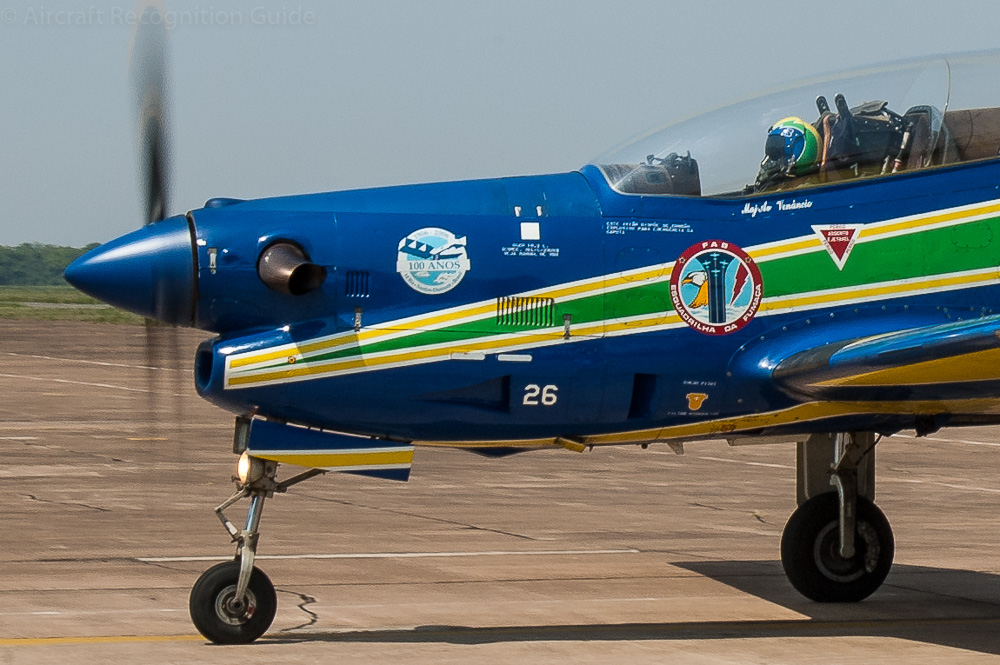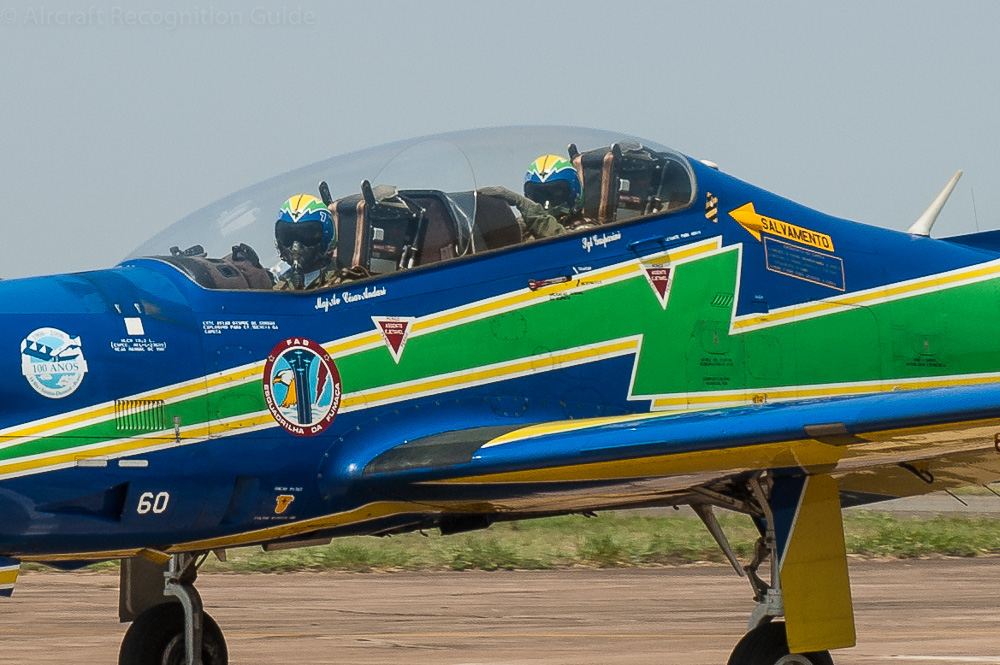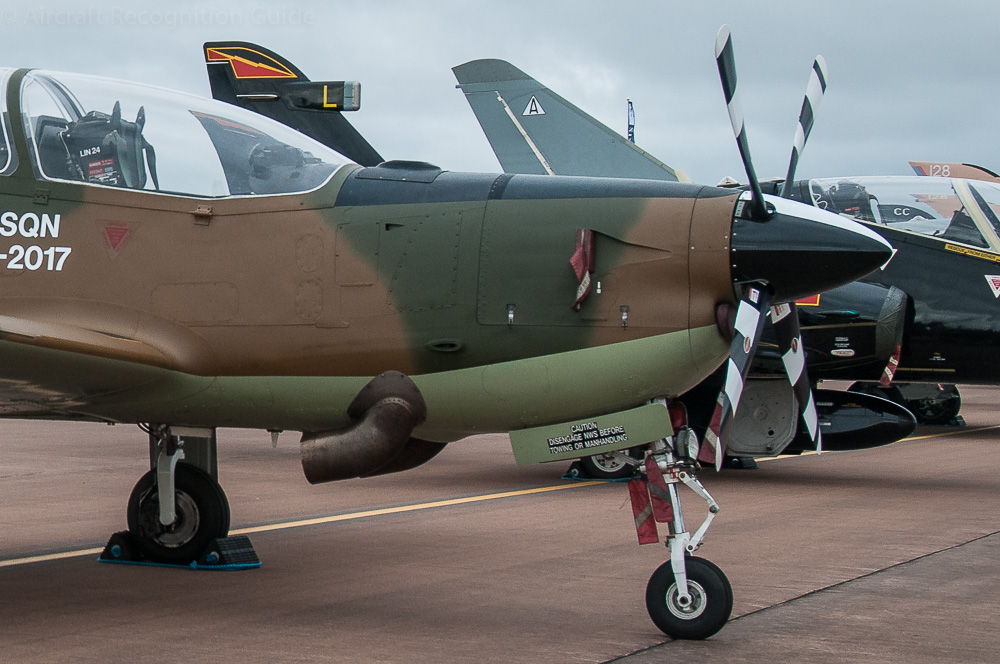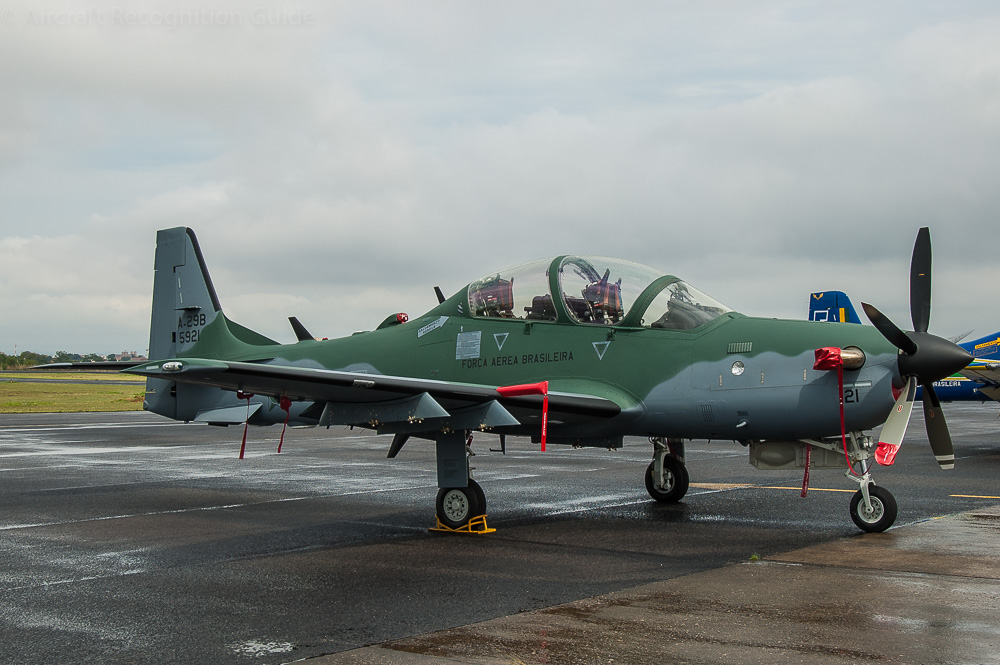
Embraer Tucano & Super Tucano
Embraer was one of the first companies to build a high performance yet inexpensive turboprop training aircraft. Many other aircraft manufacturers were to follow, developing very similar aircraft, making the life of the aviation enthusiast difficult...
Model EMB312 Tucano has straight low wings mated to a slender fuselage with a cockpit in which the instructor pilot sits higher than the student pilot. The retractable landing gear has a nose gear that is directly behind the prop, the best way to recognise the Tucano.
While the aircraft is primarily a training aircraft, there are versions with the possibility to store weapons under the wings. Additionally, Embraer even developed a dedicated attack aircraft, the Super Tucano.
The nose landing gear is placed very forward, directly behind the prop. This is the key feature of the Tucano.
Different versions
The different versions of the Tucano can be recognised by:
- the number of prop blades
- the location of the exhausts
- the shape of the canopy
- the presence of a ventral air brake
- the shape of the vertical stabiliser
EMB312A
This is the first version, built for the Brazilian air force, which gave it designation T-27. The prototype aircraft was the YT-27, while the light attack version AT-27. The latter has storage points under the wings. Also many aircraft of this subtype were exported.
The aircraft has a PT6A engine, with air intake under the prop spinner and exhaust on either side of the nose (see photo above). Up front is a propeller with three blades. The canopy is a single piece, without frames.
A version with an upgraded cockpit is called T-27M by the Brazilian air force.
EMB312F
The version for the French air force is basically the same as the EMB312A, but has other avionics and canopy de-icing. On the outside a ventral air brake should allow identification, although this is not always clearly visible.
An EMB312F of the French air force, the Armée de l'Air.
EMB312G1 & EMB312G2
Instead of a Pratt & Whitney engine this version has a Garrett TPE331 engine, being required for the Royal Air Force version. These aircraft were the development aircraft for the Short Tucano, designated EMB312S and described below.
EMB312H Super Tucano
Northrop and Embraer joint forces to bid for the Joint Primary Aircraft Training System (JPATS) competion in the United States. They made a stretched version of the Tucano, with an uprated engine driving a five bladed propeller, and a taller vertical stabiliser. The companies lost the competition to Beechcraft and Pilatus, but continued development as the EMB314.
The stretched EMB312H formed the basis for the EMB314 (photo WikiMedia/George Trussell).
EMB312S / Short Tucano
Embraer won the Royal Ar Force order for the replacement of the Jet Provost, but a different engine was needed to satisfy the time-to-climb requirements. This was the Garrett TPE331 engine, which has two big exhaust under the nose. It powers a four bladed propeller. The Short Brothers version also has a two piece canopy, with a frame between the front and back seat.
Aircraft for the Royal Air Force are known as Tucano T1, while export version for Kenya and Kuwait are designated Tucano Mk51 and Mk52 respectively.
EMB314 Super Tucano
Using the stretched Tucano (EMB312H) as a starting point, Embraer created a dedicated light attack version. It got a new model designation, EMB314, stressing that it is rather a new model than an upgrade. It maintains the new engine, five blade prop and taller tail of the EMB312H, but has a new cockpit in which the pilots sit at nearly the same level. Also the canopy is higher and consists of three parts.
The Brazilian air force uses designation A-29 for the aircraft, A-29A for the single seat version and A-29B for the dual seat. Sierra Nevada Corporation markets the Super Tucano from the USA, using the same designation, even though it is out-of-sequence.
Confusion possible with
Flying Legend Tucano R

This kitplane resembles the Tucano the most and is even called Tucano R (from replica). The Tucano R is about 25% smaller than the original. Unlike the real EMB312 it is powered by a Rotax piston engine. The intake and exhausts are nearly the same though! (photo: Mundo arma127/WikiMedia)
HAL HTT-40

The nose shape of the HTT-40 and in particular the two exhausts at either lower side of it, remind much of the Shorts Tucano. The canopy has three frames and the highest point is at the second frame. The nose gear has two wheels and the main gear single wheels that are placed at the inside of the legs. (photo: Government of India/WikiMedia)
Pilatus PC-9
The Pilatus PC-9 (and therefore Beechcraft T-6 Texan II) share a lot of similarities with the Tucano. The biggest difference is in the location of the nose gear: it is further from the prop on the Pilatus than on the Tucano. The same applies to the PC-7 and PC-21.
KAI KT-1 Woong-Bee

This Korean aircraft more resembles the Pilatus PC-9 than the Embraer Tucano, so look for the same external recognition point, the nose gear. (photo: Aldo Bidini/WikiMedia)
PZL130 Orlik
Less a Pilatus clone, but nevertheless the nose gear is so much aft that it is enough to not mix the PZL130 up with the Tucano.
Calidus B-250

Another look-a-like is this trainer/light fighter. The tail has a smaller dorsal fin and the nose gear is further from the prop, enough to avoid a mix-up with the (Super) Tucano. Compared to the regular the Tucano is has two canopy frames, just like the Super Tucano. (photo: Mztourist/WikiMedia)
TAI Hürkus
Also the last high performance turboprop training aircraft does not have the nose gear close to the prop, like the Tucano has.














